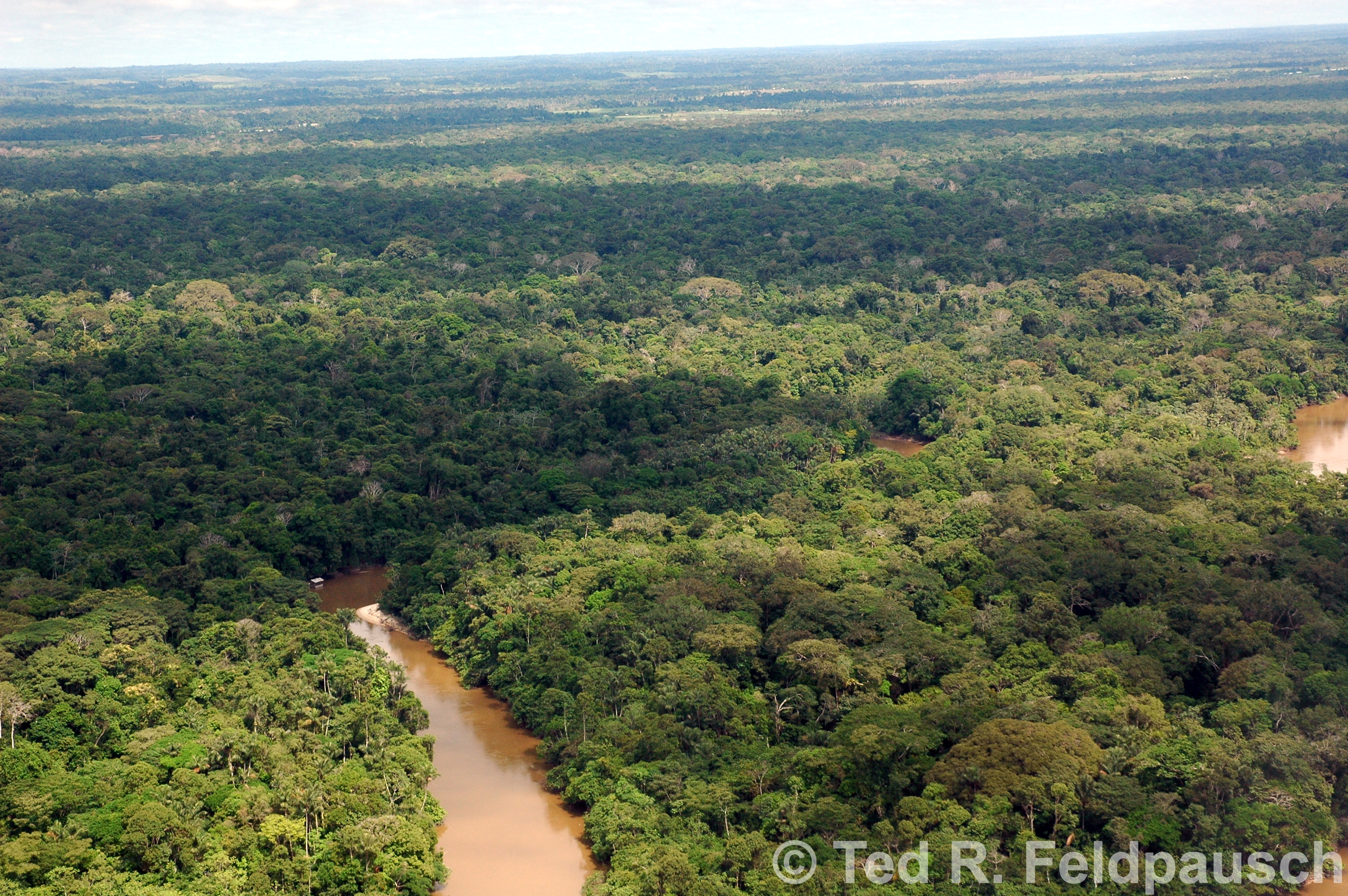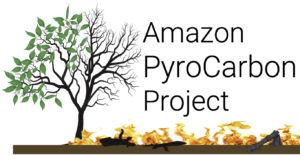
BioResilience | Amazon Past Fire | Exeter Carbon Observatory | Grants
My research group focuses on a range of topics including tropical forest ecology, land-cover land-use change, forest disturbance, degradation, and restoration, logging, forest-climate interactions, drought, fire, terrestrial carbon and nutrient cycling, and soil water use. Research spans diverse global ecosystems with a focus on lowland tropical and temperate forests, savannas, and montane systems. My research team uses approaches such as long-term vegetation monitoring, selective logging and nutrient manipulation field experiments, lidar, radar, charcoal reflectance, anthracological analysis, natural and experimental forest burning, soil and vegetation isotopes, and pyrogenic carbon analysis.

This project uses the changing Amazon biome as a natural laboratory to advance the understanding of the soil organic carbon (SOC) responses to fire and climate change and to determine the role of the environment in modulating this response (NERC NE/W001691/1). The evaluation of fire effects has traditionally focussed on aboveground carbon. However, SOC can store half of total tropical forest carbon and the impact of fire on existing SOC and the fate of new charcoal (pyrogenic carbon; PyC) is unknown. SOC loss, transformation and gain may have important implications for the carbon balance of large areas recovering from recent burning or following cycles of slash and burn agriculture, thereby altering the rate of C loss under a warming climate. Across forest plots spanning Amazonia, we are conducting measurements in baseline intact forests and human-modified forests that have been logged and burned. SOC will be partitioned into pools (e.g., labile/protected) with different turnover times and across different depths to determine the vulnerability to the loss of modern versus ancient C. This will improve the empirical foundation of DGVMs post-forest fire, building confidence in model predictions of global carbon dynamics to inform SOC management, Nationally Determined Contributions (NDCs), and climate change mitigation targets.

The BioResilience project examines the long-term resilience of Colombian forest ecosystems to environmental and climatic changes and improves understanding of the future implications of forest degradation for Colombian society (NERC/AHRC NE/R017980/1). This fills a research gap in understanding how forests, which may be regarded as biologically ‘degraded’, have undergone changes in biodiversity, in ecosystem services, and in how they participate in local and global cycles of carbon and energy. The project will evaluate biodiversity and current and historical effects of fire, and carbon storage and changing climate. These data will be integrated with socio-cultural research, focusing on existing cultures of biodiversity conservation. This understanding is essential if the scientific evidence is to be integrated into long-term management plans and policy, as forest degradation in Colombia is strongly associated with changes to the fabric of social life, including the effects of sustained conflict. The project aims to transform understanding of the controls on forest biodiversity and ecosystem service, determine ecosystem resilience to climate and disturbance, and support socio-environmental planning for sustainable resource use. There are potential topics available for student research projects studying land-use, forest ecology, and biogeography in Colombian Andean forests. The projects could make use of techniques learned in Geography GIS modules to analyse satellite and field data. The project also has access to historical air photos from our study regions to analyse time series in order to look at a variety of questions about how land-cover has changed and how change relates to climate, environment, fire, and the complex socio-political history in Colombia. There is a history of civil war, deforestation and illegal coca production, agriculture, and in some areas, tree planting. More info at the BioResilience project website.
While deforestation has declined in some tropical areas, forests are undergoing an increase in the number and area of fires. There is large uncertainty about how fire affects forests and the degree to which historical fires have contributed to the formation of modern forests. I currently coordinate two projects evaluating the effects of fire on tropical forests at two time scales: historical fires (over hundreds to thousands of years) and modern fires (within the last few decades).
Historical fire: Under a three-year project (NERC NE/N011570/1 and CAPES) we are evaluating the extent of past fires in Amazonia, including the chronology, contribution to soil pyrogenic carbon storage and the isotopic signature of past fires to evaluate whether past fires have legacy effects on the composition, structure, and dynamics of modern forests. My research group has produced the first estimate of pyrogenic carbon storage in Amazonia (Koele and Feldpausch et al. 2017) with support from the CAPES Science without Borders programme. The project builds on that work to evaluate fire-forest interactions across space and time. The results will have significant impacts in predicting the future magnitude and longevity of the Amazon carbon sink, understanding long-term fire effects, redirecting conservation practices, improving vegetation models, and affecting policy such as REDD+. More info at the Amazon Fire project website.
Modern fires: Through support from the SilvaCarbon Fund and CAPES, we use a combination of ground-based measurements, airborne lidar, and radar data to quantify how human-induced disturbances affect the uptake and release of carbon in degraded Amazon forests across the basin-wide degradation frontier. SilvaCarbon is an interagency technical cooperation program of the US Government to enhance the capacity of selected tropical countries to measure, monitor, and report on carbon in their forests and other lands. We evaluate how logging and fire disturbance modifies forest structure and species composition, and whether these changes alter trajectories of degradation and/or recovery, and forest resilience to disturbance.
Student research projects could combine these unique data on fire with ground-based vegetation and soil data and remote sensing to evaluate how fire and climate have affected and continue to affect tropical forests.
This project aims to determine the rate of lightning-induced tree mortality in the tropics (NERC NE/P001564/1). Currently, it is known that some large trees in the tropic have been killed by lightning, and it is also known that lightning strikes in the tropics probably strike trees with up to ~ 1 % of forest biomass each year. Therefore lightning could have a major influence on forest dynamics. As lightning rates increase with climate warming, the strength of the terrestrial carbon sink may even be reduced. Despite the potential significance of lightning in the tropics, there have been almost no studies on the interaction between lightning and trees in the tropics. As a consequence, estimates on the rates of lightning-induced tree mortality and subsequent lightning-driven forest carbon dynamics simply do not exist. We will perform the world’s first systematic observations of lightning-induced mortality through the large-scale deployment of novel lightning strike sensors to quantify the number of trees struck and killed by lightning over a 4 year period. This approach will allow us to address a major question of the 21st century about drivers of tree mortality in the tropics, and the resultant effect on the tropical land carbon sink.
Tropical forest degradation and regrowth is potentially a first-order component of human influence on the carbon cycle but is poorly understood. This project works to improve understanding of forest degradation, nutrient limitations and implications for forest C sinks, developing new approaches to restore tropical forests (PI Feldpausch). To date, most research on the role of tropical forests in the global C cycle has focused on “intact” forests and deforestation, with very limited emphasis on degradation and secondary forest regrowth. Previous land-use intensity and nutrient limitations may affect the rate of C sequestration in regrowing forests by resulting in nutrient loss via burning, erosion, and leaching. While CO2 fertilization may increase the terrestrial C sink, nutrient limitations may place limits on the magnitude of this effect, because tropical forest soils are acidic and nutrient impoverished, especially in P. However, almost nothing is known about how nutrient limitations such as P and Ca affect regrowing tropical forest vegetation, soil moisture dynamics, and response to drought. This project employs a long-term secondary forest fertilization experiment (15+ years) to address these knowledge gaps.
This work evaluates how long-term and more recent changes in climate affect the composition and function of tropical forests (NERC NE/I02982X/1). Shifts in species composition due to mortality from drought may have important implications on the Amazon carbon sink and ecosystem services. Approaches used in this project to evaluate change include the use of long-term forest inventory data on forest composition and dynamics spanning decades and remote sensing such as lidar and radar.
Amazonian rainforests and peatlands are the largest terrestrial tropical carbon (C) pool undergoing rapid change. Tropical peatlands have relatively well-preserved stratigraphies not found in mineral soils. The stratigraphy of these systems can be used to understand past pyrogenic carbon (PyC, a recalcitrant form of C formed by burning) inputs and their sources. There is large uncertainty about the quantity of soil C stored as PyC and the contribution of local versus transported PyC. Our research has indicated that Amazonian soil PyC may be 10 times larger than previously estimated (Koele and Feldpausch et al. 2017). Yet, there is essentially no information about how or when PyC additions to mineral or peatland soils have occurred. Understanding this process and the historical changes to this potential fertility source are essential to understanding drivers of the Amazon carbon sink. The peatlands of western Amazonia combined with our basin-wide PyC estimates provide a unique opportunity to address these data gaps. The aims of this project are to improve understanding of sources and timing of past fire and soil PyC over hundreds to thousands of years in Amazonia and quantifies the contribution of PyC to the total rainforest carbon pool and sink. Work is supported by a fully-funded PhD studentship, QUEX Initiator Grant, and Global Workshop, through the University of Exeter – University of Queensland partnership (QUEX) and the NERC Radiocarbon Facility.

The Exeter Carbon Observatory (ExCO) is an open-air ecosystem laboratory, designed by researchers from the College of Life and Environmental Sciences at the University of Exeter, and funded by the University of Exeter’s Annual Fund. This initiative aims to allow students, academics and wider society to explore and learn about the role that terrestrial ecosystems play in removing carbon dioxide from the atmosphere and the effects of climate change on the stability of carbon uptake and storage in these systems. More info at the ExCO website.
How trees develop height and crown structure can affect carbon capture, response to environmental changes, and competition for light. For example, drought response by trees and mortality from fire may be affected by the shape, size, and spatial arrangement of trees in forests. This project evaluates the drivers of variation in pantropical tree height and crown allometry and biomass in forests across South America, Africa, SE Asia, and Australia. The results will have important implications for forest management and Dynamic Global Vegetation models.